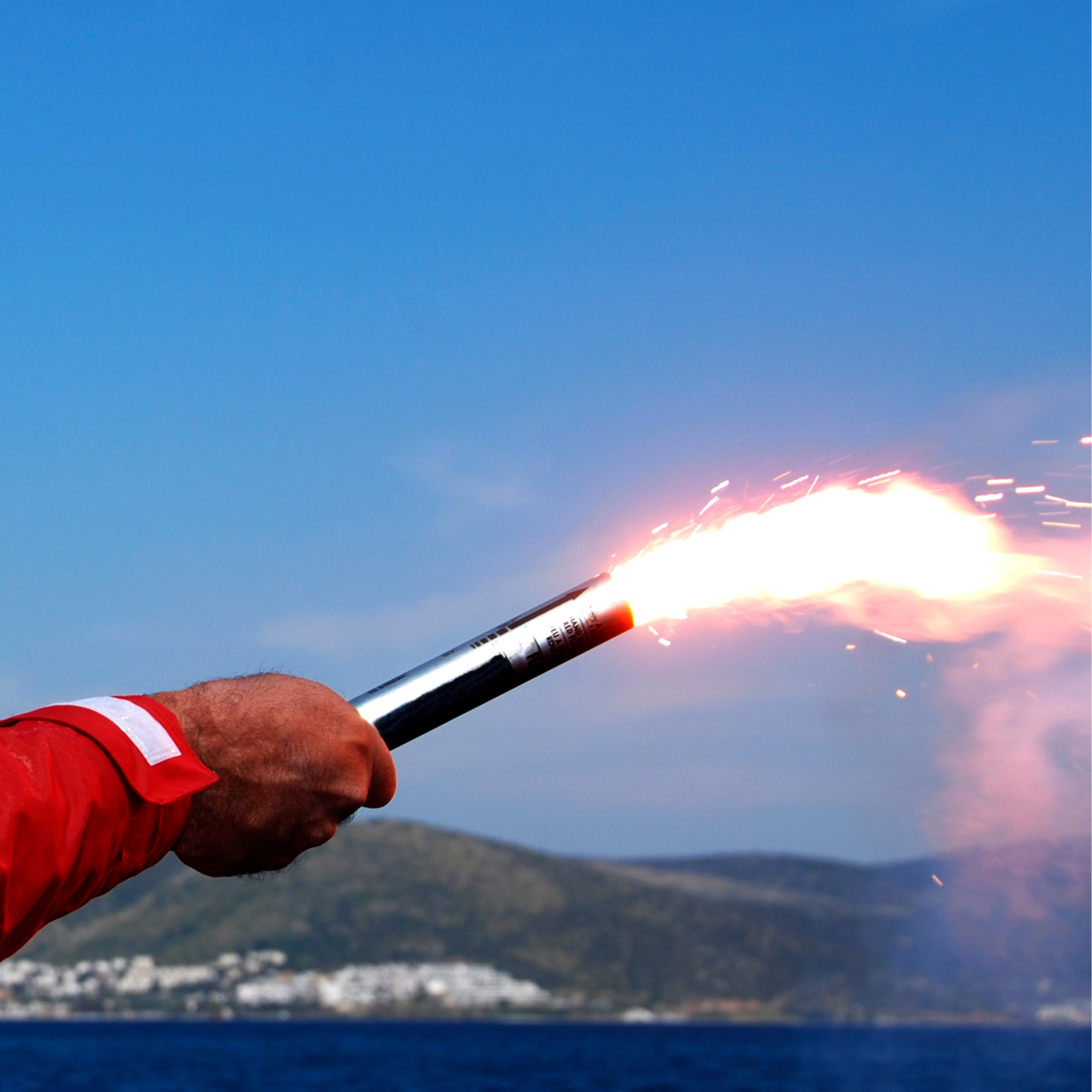FLARE TYPES EXPLAINED (AND WHICH ONES TO BUY)
Distress flares are a crucial piece of safety gear. You may never use them, but you will be extremely happy to have them on board in an emergency. They are listed in the COLREGs as an internationally recognised distress signal.
There are 5 main flare types. Let’s look at their characteristics.
ORANGE SMOKE SIGNALS
These emit a cloud of orange smoke with no luminosity, so they are visible during the day only. The hand-held kind burns for 60 seconds, while the buoyant canister type burns for about three minutes and is safe to use in petrol or oil-covered water. They have a visibility of 4km (2.5m), although this can go down to 1km (0.6m) in strong winds. They are, however, well visible from airplanes in most conditions.
RED HAND-HELD FLARES
Red hand-held flares can be used both at night and during the day when you’re in sight of another boat or a rescue helicopter. They burn for 45-55 seconds and can be seen from 10-12km (6.2-7.5m) at night and 4-6km (2.5-3.7m) during the day. Hold it downwind, outboard, and tilted away from yourself. The dross burning can ignite fuel, so be very careful.
RED PARACHUTE ROCKET FLARES
These are suitable both for day and night use. They are very bright. They project a rocket up 300m (1,000ft) in the sky and deploy a parachute-suspended red flare, which burns for about 40 seconds. They can be visible for up to 45km (28m) if the weather is good. Don’t use them if a helicopter is nearby.
MULTI-STAR FLARES
Multi-star flares create two or more stars that can reach a maximum height of 100m (328ft). Each star burns for 5 seconds and can be easily seen from the water or air.
HANDHELD WHITE FLARES
These are not used in distress situations. They attract the attention of another vessel. They can turn out helpful to avoid a collision.
WHICH DISTRESS FLARE TYPES SHOULD YOU CARRY ONBOARD YOUR BOAT?
Legislation around the type and number of flares you need to carry varies around the world. You will need to carefully research your local regulations to make sure you buy the correct set. It’s also crucial that you check that you’re buying government-approved distress flares. If you travel to another country by boat, you may have to upgrade your set to a local one.
That said, for inshore boating within 5 miles of the coast on a small to medium pleasure vessel, we recommend that you take:
2 hand-held orange smoke flares or 1 orange smoke canister
2 hand-held red flares
2 parachute rocket flares.
For offshore trips, carry:
2 hand-held orange smoke flares or 1 orange smoke canister
2 parachute rocket flares.
If you boat both inshore and offshore, you can just carry the offshore kit, but it never hurts to have extra flares.
Keep all distress flares and beacons in an easily-accessible location on your vessel. Store them in a cool dry place and pad the canister, so they can’t rattle around.
Regularly check that they’re in good condition, especially before going offshore. Marine flares expire after a few years, so you should replace them systematically. Expired flares can be extremely dangerous, especially if you try to activate them.
When you buy a set of flares, take the time to familiarise yourself with how they work. You can ask the shop assistant or read the instructions on the case. Don’t wait for an emergency situation, when you’re likely to be stressed; review the process regularly.
HOW DO YOU DISPOSE OF DISTRESS FLARES?
You can’t simply take out-of-date marine flares to a garbage collection facility. They need to be safely disposed of. There are severe penalties for the misuse of flares and you will also have to pay for the labour or loss sustained.
Below is a list of places that may discard them for you.
Marinas
Life raft service stations
Fire stations
Lifeguard stations
Police stations
Chandleries
Fireworks contractors
Before turning up to an office or station, phone up to ask if it’s a service they provide. Not all of them do. Commercial organisations usually charge for it. Some retailers offer a take-back scheme, so you may be able to bring them back to the chandlery where you bought them.
Distress flares are an essential safety item to keep onboard your boat, no matter where you go on your trips. Don’t skimp on them - they are excellent value for money.
Please check that you have the correct number and type of distress flares required by law in your country or region. Regulations vary slightly around the world. Local authorities can inspect your documents and gear anytime you’re out on the water. More importantly, flares are an excellent investment in your safety.

